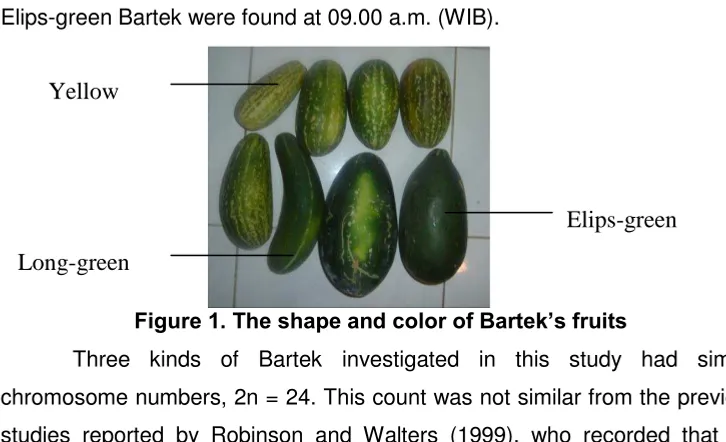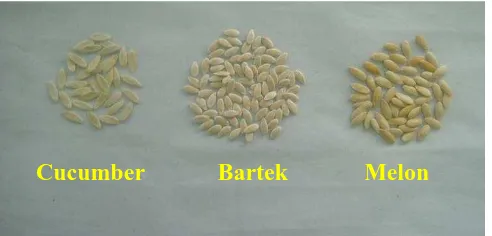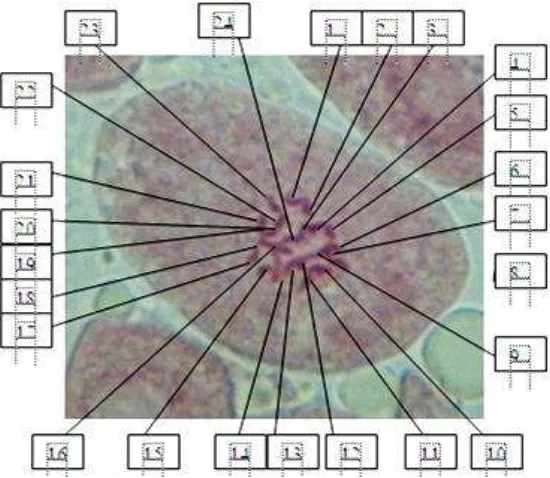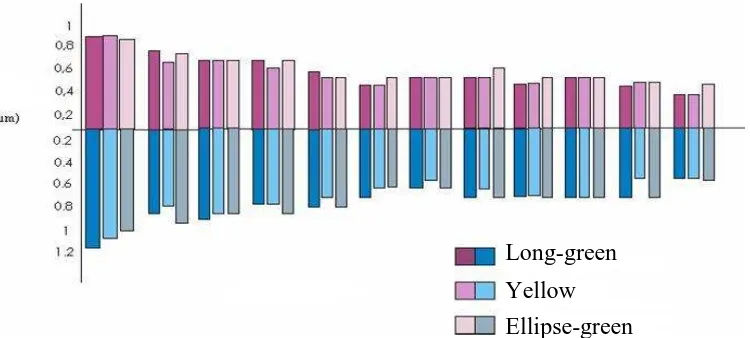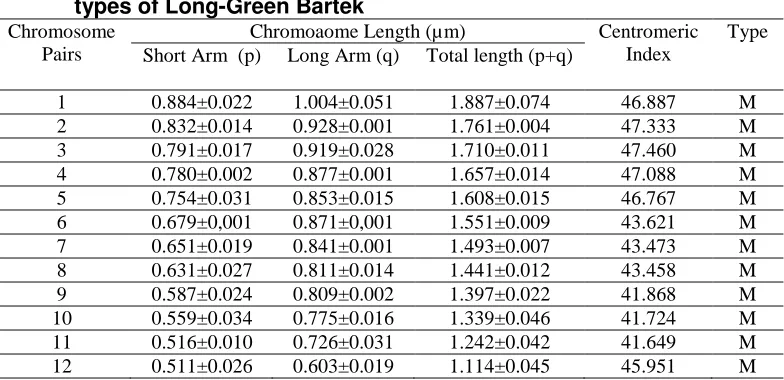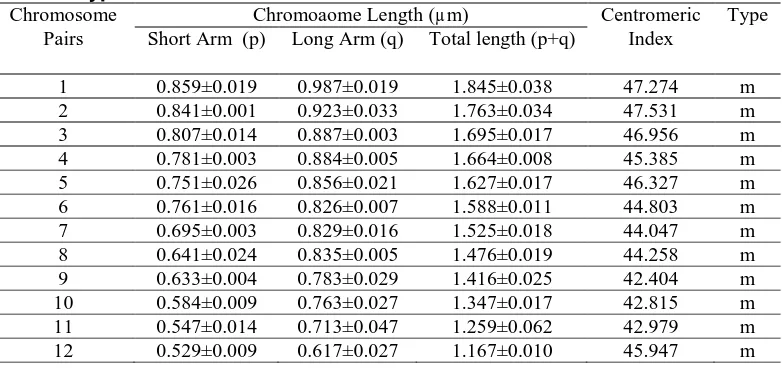Chromosome Characterization of Bartek (Cucumis Melo L. var. Bartek), Local Melon Variety from Pemalang
Karakterisasi Kromosom Timun Bartek (CucumisMelo L. var. Bartek), Varietas Melon Lokal dari Pemalang
Budi Setiadi Daryono1 and Dian Aruni Kumalawati1
ABSTRACT
Bartek is one of local melon varieties which mainly cultivated in Pemalang, Central Java. Bartek has three shapes of fruit variation; Long-Green, Ellipse-Long-Green, and Yellow. Chromosome characterization of the Bartek was investigated to determine the genetic variation. The main purpose of this research was to determine the genetic characters of Bartek including chromosome number, mitosis, cell cycle, and karyotype. Squash method was used for chromosome preparation. The results showed that all of Bartek observed in this study have similar diploid (2n) chromosome number = 24. According to total number of chromosome, Bartek is more related to melon. The mitotic analysis exhibited that the Bartek has same Karyotype formula, 2n = 2x = 24m. According to the R value of the three kind of Bartek (R< 0.27), it has indicated that three kind of Bartek were considered to be originated from same species and one of melon varieties (Cucumis melo L. var. Bartek). Key words: cucumber, bartek, chromosome, karyotype
INTISARI
Timun Bartek adalah suatu varietas melon lokal yang umum dibudidayakan di Pemalang, Jawa Tengah. Timun Bartek memiliki bentuk dan warna buah yang bervariasi, yaitu Hijau panjang, Hijau lonjong, dan Kuning. Untuk mengetahui karakter dan variasi genetik pada timun Bartek, dilakukan pengamatan karakter kromosomnya. Penelitian ini bertujuan untuk mengetahui karakter kromosom timun Bartek meliputi waktu mitosis aktif dan prometafase, jumlah, bentuk, ukuran, susunan kromosom, serta karyotype. Metode yang digunakan untuk preparasi kromosom dalam penelitian ini adalah metode pencet (squash). Hasil yang diperoleh menunjukkan bahwa ketiga timun Bartek memiliki jumlah kromosom diploid (2n) yang sama yaitu 24. Berdasarkan jumlah kromosomnya, Timun Bartek lebih tepat dikelompokkan dalam spesies melon. Hasil analisis karyotype menunjukkan bahwa ketiga timun Bartek memiliki formula karyotype yang sama yaitu 2n = 2x = 24m. Berdasarkan perbedaan selisih nilai R dari ketiga timun Bartek (R<
0,27) menunjukkan bahwa ketiga timun Bartek tersebut digolongkan dalam spesies yang sama dan merupakan salah satu varietas melon (Cucumis melo L. var. Bartek.
Kata kunci : mentimun, Bartek, kromosom, karyotype
INTRODUCTION
Melon (Cucumis melo L.) is a climbing herbaceous annual fruit vegetable belonging to the family Cucurbitacea, which consists of 90 genera and 750 species. It is a cross-pollinated diploid (2n = 2x = 14) species. Melon was originally monoecious, as are many modern cucurbit plants, but gynoecious and andromonoecious cultivars were subsequently bred. Male and female flowers were typically borne at different nodes, with the female flowers at higher nodes than the male. Fruits are round to ellipse or narrowly cylindrical, with small tubercles and spines of trichome origin on the rind. Cucumis is a genus of about 25 species, mostly tropical African in distribution.
Some are confined to tropical Asia (Robinson and Walters, 1999).
this research was to examine mitosis period, chromosome number, chromosome size, and karyotypes of Bartek. The findings of the research are expected to enrich valuable information concerning the genetic identity of the Bartek to develop local melon quality through breeding program.
Chromosome characterization can be used to determine the genetic differences among plant cultivars. Stace (1979) stated that closer relation among the cultivars will make higher similarity in their chromosome number. The chromosome number inside the nucleus was generally stabile in each species (Kimball, 1983). Chromosome characterization usually done by study the mitotic cell division, because the morphological characters of chromosome in this cell division is stabil and can be seen clearly (Min et al., 1984). The whole components of chromosome inside the cell is called karyotype. Karyotype is important to determine the identity of organisms, such as identify the taxonomical unit, biological diversity, evolution process analisys, and to determine the genetic abnormality of organisms (Jones and Luchsinger, 1979).
MATERIALS AND METHODS
1. Chromosome Preparation
2. Chromosome Analysis
The measurement of chromosome size was made on the chromosomes observed at prometaphase using Adobe Photoshop CS2 for Windows program. Centromere position of chromosome was classified by centromeric index calculated by short arm/ total length accorded to Levan et al. (1964) : metacentric chromosome with centromeric index of 37.50-50.00; submetacentric chromosome with centromeric index of 25.00-37.49; subtelocentric chromosome with centromeric index of 12.5-14.99; and telocentric chromosome with centromeric index of 0-12.49. Data of chromosome size and centromere position of chromosomes were then arranged to construct karyogram using Adobe Photoshop CS2 for Windows program, and ideogram using CorelDRAW Graphic Suite X3.
RESULTS AND DISCUSSION
Bartek has three shapes of fruit; Long-Green, Ellipse-Green, and Yellow. However, there are no specific morphological differences of the plants that produce those kinds of fruit. Bartek is generally used as a mix of a cocktail. The stems of Bartek are usually herbaceous, climbing, and branched. It can reach 138-215 cm in length with 0,7-1 cm diameters. The leaf of Bartek is about 13-18 cm long with 14-18 cm wide. The fruits of Bartek have many variations in size, but commonly, it is about 10-12 cm in length. The characters that differ the three kinds of Bartek’s fruit are the color and shape of the fruits. The color of the flesh fruits of Bartek usually change from white or pale-yellow to orange when it starts to mature.
Elips-green Bartek were found at 09.00 a.m. (WIB).
Figure 1. The shape and color of Bartek’s fruits
Three kinds of Bartek investigated in this study had similar chromosome numbers, 2n = 24. This count was not similar from the previous studies reported by Robinson and Walters (1999), who recorded that the diploid chromosome number of cucumber species was 14. However, Robinson and Walters (1999) also explain that the most common haploid numbers of Cucurbitaceae’s chromosome were 11 and 12. Therefore, it could be concluded that Bartek was Cucurbitaceae family member and one of melon varieties. According to the research of PI 371795 melon and American muskmelon reported by Winarsih (2007) and Dewei et al. (2005) the chromosome number of Bartek is more related to Melon (2n=2x=24). In previous studies, the karyotype formula of several species in Cucurbitaceae family had been investigated. In this case, melon used as the comparison of Bartek because their similarity in chromosome number (2n=2x=24). The karyotipe formula of several cultivars of Cucurbitaceae showed variation.
Karyotype formula that same to Bartek belongs to PI 371795 melon
(2n=2x=24). This result was reported by Winarsih (2007). While, the different karyotype formula belongs to American muskmelon (Cucumis melo var. reticulatus) which has 2n=2x=20m+2sm+2sm(SAT) chromosome formula,
and Hetian melon (Cucumis melo spp. melo Pang) which has 2n=2x=24=18m+4M+2sm chromosome formula (Dewei et al., 2005). Those karyotype formula showed that American muskmelon and Hetian melon have
Yellow
Bartek
Elips-green
Bartek
Long-green
two types of chromosome, metacentric and submetacentric chromosome, which then determined to be symmetry and asymmetry. The close relation between Bartek and Melon can also bee seen from the shape of the seed. The seed of Bartek is more similar to melon than cucumber.
Figure 2. The comparison of the seed’s shape of cucumber, Bartek, and melon
Singh (1999) stated that symmetry karyotype was more primitive than the asymmetry karyotype. Therefore, it could be known that plant varieties with asymetric chromosome in its karyotype have better step of evolution than plant varieties with symetric chromosom in all of its part. It also could be revealed that Bartek has ancient evolution step because it doesn’t have asymetric chromosome in its karyotype.
Moreover, the chromosome number of Bartek is also similar to white Bartek (Ariwarsi, 2008) and Timun Suri (Wicaksono, 2008). In addition all chromosome of Bartek also appeared to have the centromere in the median region and were thus classified as metacentric according to Levan et al. (1964) displaying similar karyotype formula 2n = 2x = 24 = 24m. In addition, autotetraploid chromosome numbers were appeared in Ellipse-Green Bartek (2.22%). It was small number compare to diploid chromosome (97.78%). Autotetraploid chromosome indicates natural mutation because Bartek has not been developed using polyploidization mutation agent. The centromeric index of Yellow, Ellipse-Green, and Long-Green Bartek was about 43.283-48.065; 42.404-47.531, and 41.649-47.460 respectively. The finding of
metacentric chromosomes in Bartek revealed that Bartek investigated in this study have symmetry karyotypes indicating that Bartek have not been widely developed through breeding program. The phylogenetic research reported by Renner, et al. (2007) showed that the relation between cucumber and melon is not too close. Based on congruent nuclear and chloroplast phylogenies, they concluded that Cucumis comprises an old Australian/Asian component that was heretofore unsuspected. Cucumis sativus evolved within Australian/Asian clade is phylogenetically far more distant from Cucumis melo than implied by the current morphological classification. Hence, since Bartek has similar chromosome numbers with melon, it could be revealed that Bartek and melon are same species.
Figure 4. Karyotype of Yellow Bartek. Scale bar correspond to 5µm. (m = metacentric chromosome; number under the karyotype correspond to
chromosome pairs)
Figure 5. Karyotype of Ellipse-Green Bartek. Scale bar correspond to 5µm. (m = metacentric chromosome; number under the
karyotype correspond to chromosome pairs)
Figure 6. Karyotype of Long-Green Bartek. Scale bar correspond to 5µm. (m = metacentric chromosome; number under the karyotype
correspond to chromosome pairs)
Figure 7. Ideogram showing comparison chromosome size among Yellow, Elips-green, and Long-green Bartek
As shown in Figure 1, 2, and 3, it could be seen that no satellites found in all karyotypes. Even though three types of Bartek showed similar
Long-green
Yellow
chromosome numbers and karyotypes, they revealed different chromosome size from each other (Figure 4 and Table 1, 2 and 3). The largest chromosome total length of Yellow, Ellipse-Green, and Long-Green Bartek was 1.845 µm, 1.844 µm, and 1.887 µm respectively, whereas the smallest chromosome total length of Yellow, Ellipse-Green, and Long-Green Bartek was 1.167 µm, 1.118 µm, and 1.114 µm respectively. Short arm chromosome of Long-Green Bartek was smaller than the others. While the long arm chromosome of Ellipse-Green Bartek was longer than the others. The smallest short arm chromosome of Yellow, Ellipse-Green, and Long-Green Bartek was 0.529 µm, 0.512 µm, and 0.511 µm respectively, while the largest short arm chromosome of Yellow, Ellipse-Green, and Long-Green Bartek was 0.859 µm, 0.887 µm, and 0.884 µm respectively. The smallest of long arm chromosome of Yellow, Ellipse-Green, and Long-Green Bartek was 0.617 µm, 0.605 µm, and 0.603 µm respectively whereas the largest long arm of Yellow, Ellipse-Green, and Long-Green Bartek was 0.923 µm, 1.062 µm, and 1.004 µm respectively. The result showed variation with the previous studies reported by Chen, et al (1998), who recorded that the chromosome number of Cucumis is 2n=2x=14.
(Lin-Chu dan Yu-Xi, 1996), Amentoraxis argotaenia (R=2.71) and A. yunnanensis (R=2.59) (Qi-Xing et al.,2000). Furthermore, on the basis of the
difference of R value in the three kinds of Bartek (R< 0.27) indicated that three kinds of Bartek had close genetic relationship.
Further chromosome studies on other Cucumis species from Indonesia will be needed to identify more precisely genetic identity of cucumber species of this country. This is due to plant breeders have always been appreciating enhancement of the existing gene pool, and chromosome studies would be helpful in the enrichment of the existing Cucumis germplasm resources of the country to develop Cucumis industry.
Table 1. Chromosome length, centromeric index, and chromosome types of Long-Green Bartek
Chromosome Pairs
Chromoaome Length (µm) Centromeric
Index
Type Short Arm (p) Long Arm (q) Total length (p+q)
1 0.884±0.022 1.004±0.051 1.887±0.074 46.887 M
2 0.832±0.014 0.928±0.001 1.761±0.004 47.333 M
3 0.791±0.017 0.919±0.028 1.710±0.011 47.460 M
4 0.780±0.002 0.877±0.001 1.657±0.014 47.088 M
5 0.754±0.031 0.853±0.015 1.608±0.015 46.767 M
6 0.679±0,001 0.871±0,001 1.551±0.009 43.621 M
7 0.651±0.019 0.841±0.001 1.493±0.007 43.473 M
8 0.631±0.027 0.811±0.014 1.441±0.012 43.458 M
9 0.587±0.024 0.809±0.002 1.397±0.022 41.868 M
10 0.559±0.034 0.775±0.016 1.339±0.046 41.724 M
11 0.516±0.010 0.726±0.031 1.242±0.042 41.649 M
Table 2. Chromosome length, centromeric index, and chromosome
ACKNOWLEDGMENTS
I would like to extend special thanks to Charisma Eko Wicaksono and Fiddiyati for their valuable discussion in relation to chromosome analysis using Adobe Photoshop CS2.
REFFERENCES
Ariwarsi, T. 2008. Siklus Sel dan Jumlah Kromosom Timun Bartek Bule (Cucumis spp.). Undergraduate Thesis. Fakultas Biologi UGM. P.17. Chen, J, J.E Staub, J. Jiang. 1998. A Reevaluation of Karyotype in Cucumber
(Cucumis sativus L.). Springer Netherlands 45: 16-19
Dewei, M, G. Zhenhuai, Z. Chenghe, G. Suozhu, and W. Ming. 2005. Chromosome Number and Karyotype of Melons (Cucumis melo L.). Acta Horticulturae 17:61-65
Jahier, J and A.M. Tanguy. 1996. Observation of Chromosomes: Basic Techniques (Mitosis) of Plants Cytogenetics. Science Publishers Inc. New Hampshire. USA. pp 3-5
Jones, S.B and A.E Luchsinger. 1979. Plant Systematics. McGraw-Hill Book Company. USA. p : 65
Kimball, J.W. 1983. Biologi. Edisi Kelima. Penerbit Erlangga. Jakarta. pp : 197-200
Levan, A., K. Fredga and A.A. Sanberg. 1964. Nomenclature for Centromic Position on Chromosome Hereditas. 52 : 201-202
Liang, L., X. Ling-Ling, and Y. Di-Qing. 1991. Studies on Karyotypes of 5 Species in Ranunculus From Jiangxi. Acta Phytotax. Sin. 29 (2) :178-181.
Lin-Chu, L. 1992. The Karyotype of Arthrotaxiz (Taxodiaceae) and Its Systematic Position. Acta Phytotax. Sin. 30 (4): 331
Lin-Chu, L. 1993. Studies on The Karyotype and Systematic Position of Larix Mill. (Pinaceae). Acta Phytotax. Sin. 31 (5): 407-408
Lin-Chu, L and F. Yu-Xi. 1996. The Karyotype and The Cytogeography of Cupressus (Cupressaceae). Acta Phytotax. Sin. 34 (2): 119-121 Min, H.G, H.T Ma, and G.H Liang. 1984. Studies of Genetics. The MacMillan
Company. New York. p : 5
Renner, S.S, H. Schaefer, and A. Kocyan. 2007. Phylogenetics of Cucumis (Cucurbitaceae) : Cucumber (C. sativus) belongs in an Asian/Australian clade far from Melon (C. melo). BMC Evolutionary Biology. 7:58
Robinson, R.W, D.S Walters. 1999. Cucurbits. CAB International. Cambridge. pp 61-63
Samadi, B. 2002. Teknik Budi Daya Mentimun Hibrida. Penerbit Kanisius. Yogyakarta. Pp. 9-22
Stace, C.A. 1979. Plant Taxonomy and Biosystematics. Second Edition. Edward Arnold. London. pp 13-26
Trehane, P., Brickell, C.D., Baum, B.R., Hetterscheid, W.L.A., Leslie, A.C., McNeill, J., Spongberg, S.A. and Vrugtman, F. 1995. International code of nomenclature for cultivated plants-1995. Quaterjack Publishing, Wimborne, United Kingdom. p. 175.
Wicaksono, C.E.2008. Perbandingan Karyotype Timun Suri (Cucumis spp.) Lokal Jawa, Kalimantan dan Sulawesi. Thesis. Fakultas Biologi Universitas Gadjah Mada. p. 40.
